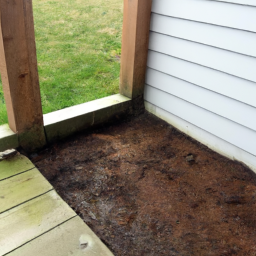How To Fix Muddy Backyard
How To Fix A Muddy Backyard
How To Fix A Muddy Backyard: An Extensive Guide
Assessing the Problem
The first step in fixing a muddy backyard is to assess the current state of the yard and determine why the mud is forming. This requires evaluating the type of soil, climate, and rainfall in your area along with the slope of the ground, and the drainage of the area. Once you have identified the key factors that are causing the mud to form, it is time to move onto the next step fixing the problem.
What Kind of Soil Do You Have?
The type of soil in your yard has a significant impact on the potential for mud. Clay soils are typically more prone to mud formation due to their lower water infiltration rate, whereas sandy and loamy soils tend to retain water better and create a stronger base for the mud to form on. It is important to identify the type of soil in your yard and how it interacts with the environment around it.
Climate and Rainfall in Your Area
The local climate and rainfall can also have a significant impact on the potential for mud in your yard. In higher rainfall areas, the potential for mud is higher, whereas in dryer climates, the soil is more likely to be drier, and the risk of mud is much lower. Also, areas with more extreme temperatures can create potential problems, as fluctuating temperatures cause the soil to expand and contract, leading to more mud formation.
Understanding Slope and Drainage
Slope and drainage play a critical role in the formation of mud in a backyard. If the land is sloped in such a way that it allows water to pool in certain areas, then this creates potential mud pits that can be difficult to avoid. On the other hand, flat land that has proper drainage can limit the potential for mud to form.
Assessing the Slope
Using a ruler or yardstick can help you determine the slopes in your yard. By measuring the elevation changes in different areas, you can get a better understanding of how water will move across the land. If the land is flat, then water can move easily, thereby limiting the potential for mud formation. If the land is sloped, then water can pool, and mud can start to form.
Creating a Drainage Path
Once you have identified the potential problem areas in your yard, it is time to look into creating a drainage path. One way to do this is to create a channel of mulch or gravel, with the aim of guiding water away from mud areas. You can also add drainage tiles to the ground which will allow for water to move away from the potential mud areas. Lastly, you can plant ground cover plants in problem areas, helping to block water from pooling and creating mud.
Final Touches: Maintenance and Other Considerations
Lastly, it is important to recognize that mud is a living organism, and that regular maintenance is key to keeping it at bay. Regularly reseeding the area with grass seed, top dressing the lawn with sand or loam, or even aerating the area can all aid in reducing the chances of mud formation. It is also important to be mindful of other issues which can contribute to mud such as animals running through the area or weeds taking over.
Closing Remarks
Muddy backyards can be a challenge to contend with. However, by assessing the factors that could cause it, such as soil types, climate, drainage, and the slope of your land, you can start to get a better understanding of how to fix the problem. With proper care and maintenance, you can turn that mud into a beautiful backyard!

Previous Page
